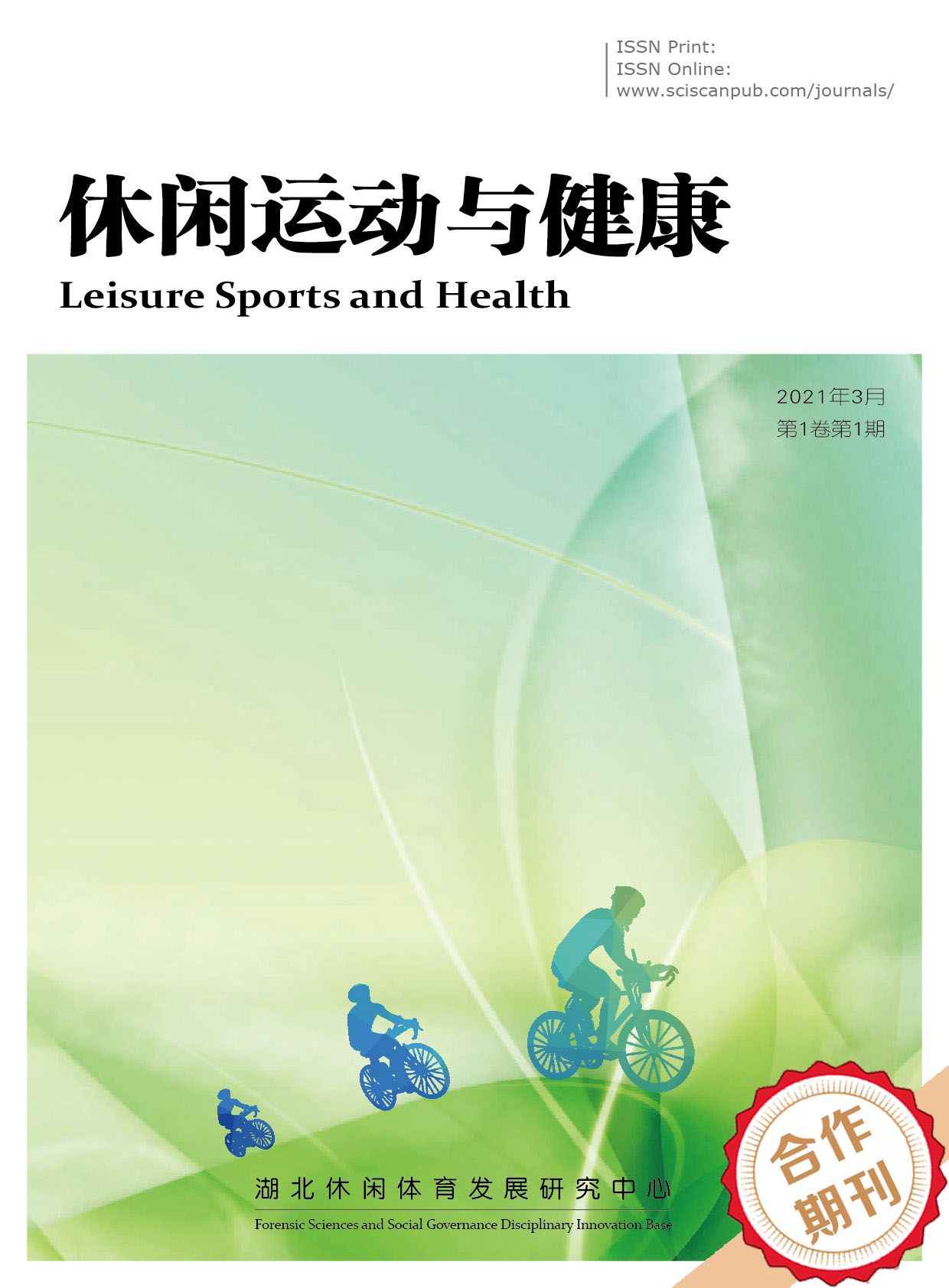Leisure Sports and Health
中国台球运动差异化发展路径研究
Research on the Differentiated Development Path of Billiards in China
- Authors: 付选申
-
Information:
湖北大学体育学院,武汉
-
Keywords:
Chinese eight-ball; Snooker; Differentiated development; Massification; Internationalization; Dual-track collaboration中式八球; 斯诺克; 差异化发展; 群众化; 国际化; 双轨协同
- Abstract: This study focuses on the differentiated development paths of Chinese eight-ball and snooker in China, which run in parallel. Through analysis, it is found that cultural genes and policy guidance constitute the core driving forces: Chinese eight-ball, relying on the simplification of local rules and the popularization of domestic equipment, has established a “low threshold, wide participation” mass-oriented downward model. Its community events and short-video marketing have effectively activated the markets in third- and fourth-tier cities and resonated with the night market economy of billiard halls in Xinjiang. Snooker, on the other hand, has shaped a high-end competitive image by virtue of its professional competition system and the “Ding Junhui model”, and its internationalization path is similar to that of the Wuhan Open Tennis Tournament. In terms of commercialization, Chinese eight-ball has formed a regional closed-loop ecosystem of “culture and tourism + local sponsorship”, while snooker relies on international brand cooperation but faces the challenge of an aging audience. Policy differences have exacerbated the differentiation: Chinese eight-ball benefits from the national fitness policy, while snooker receives resource inclination under the “Olympic Glory” strategy. The study reveals structural contradictions faced by both types of sports, such as the professionalization gap and rule export obstacles of Chinese eight-ball, and the elite isolation and youth training disconnection of snooker. Therefore, a “dual-track synergy” strategy is proposed: Chinese eight-ball needs to strengthen the industry-university-research mechanism, and snooker should promote the “mini table” inclusive design. At the policy level, it is suggested to establish a tiered development fund to promote venue sharing and rule mutual recognition. This study provides a theoretical reference for balancing local characteristics and international standards and has practical significance for optimizing the billiards sports ecosystem. 本研究聚焦中国台球运动中式八球与斯诺克双轨并行的差异化发展路径。通过分析发现,文化基因与政策导向构成核心驱动力:中式八球依托本土规则简化与国产器材普及,构建“低门槛、宽参与”的群众化下沉模式,其社区赛事与短视频营销有效激活三四线市场,并与新疆台球厅夜市经济形成共振;斯诺克则凭借职业赛事体系与“丁俊晖模式”塑造高端竞技形象,其国际化路径与武汉网球公开赛经验相通。商业化方面,中式八球形成“文旅+本土赞助”区域闭环生态,斯诺克依赖国际品牌合作,但面临受众老龄化挑战。政策差异加剧分化:中式八球受益于全民健身政策,斯诺克获“奥运争光”战略资源倾斜。研究揭示两类运动面临中式八球职业化断层与规则输出障碍、斯诺克精英化孤岛与青训割裂等结构性矛盾。为此,提出“双轨协同”策略:中式八球需强化产学研机制,斯诺克应推广“迷你球桌”普惠设计;政策层面建议设立分级发展基金,推动场地共享与规则互认。本研究为平衡本土特色与国际标准提供了理论参照,对优化台球运动生态具有实践意义。
- DOI: https://doi.org/10.35534/lsh.0501001
- Cite: 付选申.中国台球运动差异化发展路径研究[J].休闲运动与健康,2025,5(1):1-6.
台球运动自20世纪80年代引入中国以来,经历了从街头娱乐向竞技体育的转型,形成了中式八球与斯诺克双轨并行的独特格局。中式八球通过本土规则重构与国产器材普及[2],构建起覆盖三四线城市的群众化网络;斯诺克则依托职业赛事体系与丁俊晖等明星效应[6],塑造了高端竞技形象。这一分化现象与苏州俄式台球的本土化实践、秦皇岛中式台球产业的大众—专业共生模式共同构成了中国台球运动的生态图谱,折射出全球化与本土化张力下非奥运项目的发展困境与创新可能[11]。现有研究多聚焦于单一项目分析,如武汉台球俱乐部消费行为研究或斯诺克技术训练体系,缺乏对差异化路径的系统比较[12]。实际上,两类运动的路径选择具有深刻的理论关联:中式八球的“去精英化”与台球器材商办赛策略形成呼应[13],其下沉市场逻辑与新疆台球厅的夜市经济特征具有相似性[4];斯诺克的国际化则与武汉网球公开赛的顾客满意度管理共享高端赛事运营经验[7]。然而,分化发展也引发了实践矛盾:中式八球的职业化断层与斯诺克青训体系割裂暴露了资源分配失衡,两类运动在政策支持(全民健身导向vs奥运争光战略)与商业化路径(本土赞助vs国际品牌)上的分野亟待理论阐释。基于此,本研究提出核心问题:(1)中式八球如何通过规则简化与市场下沉实现群众化渗透?(2)斯诺克在职业化进程中如何平衡国际化标准与本土文化适配?(3)两类运动的差异化路径是否存在生态互补可能?通过整合台球器材营销策略[9]、消费者行为研究及赛事运营经验[5],本文突破了单一项目分析框架,构建了“群众化—竞技化”双轨发展的理论模型。研究结果可为优化台球产业政策、推动规则创新提供决策依据,亦可为武术、毽球等传统项目平衡本土特色与国际标准提供理论参照。
1 中式八球与斯诺克的历史溯源与文化定位
台球运动的双轨发展根植于不同的历史语境与文化土壤。中式八球与斯诺克虽同属台球范畴,却在规则演进、技术传承与符号建构中形成了鲜明分野。本节结合中国台球运动的在地实践,系统梳理了两类项目的历史脉络与文化定位。如表1所示。
表 1 中式八球与斯诺克历史溯源与文化定位对比
| 维度 | 中式八球 | 斯诺克 |
| 历史溯源 | 20世纪80年代街头台球本土化改良 | 19世纪英国殖民文化跨国移植 |
| 规则特征 | 简化规则(自由球制、抢局制) | 复杂规则(指定球、147分制) |
| 文化符号 | 地域冠名赛事、草根逆袭叙事 | 绅士礼仪、全球化赛事IP |
| 空间实践 | 社区茶馆、夜市广场等开放场景 | 高端俱乐部、专业场馆封闭场景 |
| 技术传承 | 师徒制经验教学(实战主导) | 科学化训练体系(生物力学分析) |
| 政策导向 | 全民健身政策支持(基层设施补贴) | 奥运争光战略(职业选手专项投入) |
中式八球与斯诺克的文化基因差异塑造了中国台球运动的双轨格局。中式八球起源于20世纪80年代街头娱乐的本土化改良,通过缩小球桌尺寸(2.2米×1.1米)、简化规则(取消指定球制度)和国产器材普及(单价降至3000元内),构建了“低门槛、高参与”的群众体育模式。其赛事嵌入地域标识(如“河北·秦皇岛杯”),依托社区场景和草根逆袭叙事形成了地域文化符号,与新疆台球厅夜市经济形成了下沉市场共振。反观斯诺克,作为英国殖民文化的舶来品,其规则体系(147分制、严格击球顺序)与赛事礼仪(正装参赛、观众静默)延续了精英化传统,通过丁俊晖模式和国际赛事IP(如上海大师赛)塑造了高端竞技形象。两类运动在生态格局上形成了鲜明分野:中式八球形成了“大众参与—商业反哺”的内生循环,而斯诺克依赖全球资源构建了职业化体系。这种文化分野导致了结构性矛盾——群众项目职业化断层与竞技项目普惠性缺失并存,亟待通过政策统筹(如场地分时共享)和技术协同(生物力学模型转化)实现资源优化配置,推动中国台球运动生态的良性发展。
2 中式八球与斯诺克发展路径的差异化比较
2.1 普惠下沉与精英壁垒:受众定位差异
中式八球与斯诺克在受众定位上形成“普惠下沉”与“精英壁垒”的鲜明分野。中式八球通过“规则降维+成本压缩”策略,将目标市场锁定在三四线城市工薪阶层(占比52%)、中老年休闲群体(28%)及青少年学生(20%)[12],其成功得益于三重创新:器材国产化使球桌价格降至2800元,场景革新突破传统场地限制,以及规则简化降低技术门槛[1]。这种下沉策略与新疆台球厅“夜市经济”的消费特征形成跨地域呼应[4]。反观斯诺克,其倒金字塔型受众结构(职业选手占比8%、中高收入群体32%、培训群体60%)[9]依赖三重壁垒维系——万元级进口器材、2000小时/年专业训练[15]和Q School资格赛92%淘汰率[5]。这种精英定位虽巩固了竞技高度,却导致青少年参与率不足10%[20]。破解矛盾需借鉴秦皇岛“大众—专业”共生模式[11],通过分时共享场地促进资源流动。
2.2 本土闭环与全球嫁接:商业化模式差异
两类运动的商业化呈现“本土深耕”与“国际嫁接”的路径差异。中式八球构建区域闭环生态:乔氏杯大师赛70%资金源于器材商赞助,抖音直播带货转化率达8.7%[18],赛事与地方节庆绑定带动周边消费增长25%[8]。这种“器材商主导+文旅融合”模式虽具市场灵敏度,但过度依赖单一企业[16]。斯诺克则依托全球IP矩阵,形成“三大赛+11站排名赛”体系[5],奔驰、劳力士等国际品牌贡献60%收入[19],但中国本土企业参与不足5%[9]。其800万美元/年的转播收益[5]与1.2%付费转化率折射出文化适配困境。优化方向可参考武汉台球俱乐部分层会员体系[17],在斯诺克赛事中增设区域品牌合作专区,同时强化中式八球商业生态的抗风险能力。
2.3 全民健身与奥运战略:政策支持差异
政策导向差异强化发展路径分化。中式八球受益于全民健身政策:30%三四线城市将社区台球厅纳入“15分钟健身圈”,地方赛事获30%~50%财政补贴,14所高职院校开设指导员认证[10]。此类基层扶持与新疆“台球夜市”管理经验形成联动[23],但暴露专业人才缺口[19]。斯诺克则聚焦竞技资源倾斜:1200万元/年国家队投入[7]、A类赛事15%税收减免[5],以及市场化青训体系(年均学费8万元)[9]。“奥运争光”战略虽培育了12位TOP32选手,却导致70%资源集中于头部赛事[7]。破解失衡需建立分级管理机制[5],如将中式八球社区联赛纳入体育产业统计范畴,同时设定斯诺克商业赛事的社会责任投资比例。
2.4 经验传承与科学训练:技术体系差异
技术传承路径呈现“经验主导”与“科学训练”的范式分野。中式八球延续师徒制传统:技术习得依赖实战经验,“翻袋”成功率方差达23%[1],全国仅2所高校开展相关研究[15]。这种模式与经营性俱乐部教学实践形成互补,但导致标准化滞后。斯诺克构建产学研体系:运用高速摄像机量化杆速(±0.03m/s误差)与击球角度(±0.5°精度)[15],开发低摩擦台呢(系数0.68±0.02)[19],应用脑电技术强化心理训练[19]。科学化路径虽提升竞技水平,但50万元/套设备成本制约基层普及[9]。建议建立联合实验室,推动斯诺克力学模型[15]与中式八球实战数据的知识转化,同时制定器材分级标准降低技术准入门槛。
2.5 地域深耕与绅士叙事:文化认同建构差异
文化符号运作呈现“地域深耕”与“国际叙事”的双向张力。中式八球通过三重维度建构认同:89%的赛事采用城市冠名[8],2.3万个民间协会自主组织社区联赛[6],草根选手逆袭故事强化情感共鸣[2]。这种“地域绑定+社群自治”模式与秦皇岛“城市名片”策略共振,但国际传播受限。斯诺克则融合绅士礼仪(选手正装率100%)[5]与国家叙事(丁俊晖作为全球化符号)[6],其文化移植虽塑造了高端形象,却因商业代言争议暴露文化折扣。优化路径可设计“中国斯诺克文化季”,将中式八球地域符号与斯诺克礼仪规范创意嫁接,同时建立弹性规则框架平衡文化差异。
2.6 规则输出与标准嵌套:国际化路径差异
两类运动在国际化进程中面临“规则输出”与“标准嵌套”的差异化挑战。中式八球推广受阻于规则争议(南非抗议自由球制度)与文化误植(海外赛照搬“唐山杯”命名),其“单向输出”问题类似苏州俄式台球早期困境[14]。斯诺克通过三重调适实现本土化:融合武术腕部训练法[6]、增设15%外卡名额[5]、植入水墨视觉元素[12],这种“标准嵌套”策略与武汉网球公开赛服务创新形成互补。建议构建动态平衡机制:中式八球可建立多版本规则体系,斯诺克需深化文化阐释,如开发双语技术手册,既保留核心竞技标准,又融入区域文化符号。
3 中式八球与斯诺克案例分析
3.1 乔氏杯大师赛:下沉市场的本土化突围
乔氏杯中式八球国际大师赛通过“硬件降维+场景创新”策略,成功撬动下沉市场。在硬件降维方面,赛事自主研发单价仅2800元的2.2米国产球桌(较斯诺克球桌成本降82%)[2],并采用树脂球使整套器材成本降至800元/套[1],显著降低投资门槛,推动三四线城市台球厅投资回收周期缩短至8个月[12],加速了基层设施普及。在场景创新方面,通过将球桌嵌入文旅场景(如沙河梨花节带动周边消费增长37%)[8]、运用抖音“边赛边卖”实现单场台呢销售580万元[2],以及设计“黄金8抢位赛”吸引23.7万人次虚拟参与并保留外卡激励本地选手,有效打破空间限制并创造增量价值。成效显著,硬件降维激活了下沉市场铺设,创新场景与赛制将青少年参与率提升至28%[12]。然而,挑战并存:赛事运营高度依赖乔氏品牌(承担72%成本),赞助结构单一化风险突出。同时,海外推广中中式规则与国际惯例的差异引发争议,阻碍国际化进程[16]。未来需构建多元赞助体系(如引入文旅联合冠名)并制定弹性规则框架(适配海外区域特色),辅以AI裁判系统开发[14],以保障赛事可持续发展。
3.2 上海大师赛:国际化与本土化的博弈困局
上海斯诺克大师赛通过“全球积分深度绑定”与“科学训练体系支撑”双核策略,成功树立了赛事职业高度。赛事冠军可获得高达8000点世界排名积分[5],这一极具吸引力的激励成功确保了世界排名TOP16选手的全员参赛,奠定了其顶级赛事的地位。在人才培养方面,上海台球学院引进英国成熟的Q School职业选拔体系,并融合尖端科技,运用2000帧/秒高速摄像机进行动作捕捉与分析,将选手的杆法误差精准控制在±0.3°以内,显著提升了训练的科学性与效率。然而,赛事的本土化创新呈现矛盾性特征[15]。一方面,2022年采用的“水墨上海”视觉设计理念,虽旨在融合传统文化,却引发了37%国际观众对其文化适配性的质疑,反映出国际化传播中的文化折扣问题。另一方面,丁俊晖团队创新性地融合中国传统武术“缠腕”技法于击球动作,经测试验证,成功将平均击球速度提升了0.8m/s,展现了本土智慧对竞技表现的积极赋能[6]。在青训体系构建上,赛事推出“明日之星”外卡赛机制,每年选拔12名14岁以下潜力新秀,为青少年提供直通高水平赛事的宝贵通道[9]。但不容忽视的是,年均高达50万元的精英化训练投入,构筑了显著的准入门槛,限制了更广泛人才的发掘与培养。在商业化层面则呈现出“国际品牌主导,本土参与薄弱”的格局。顶级国际品牌如梅赛德斯-奔驰、劳力士占据了赛事总赞助额的68%,显示出强大的国际吸引力[5]。相比之下,本土商业价值挖掘不足,例如限量版球星签名球杆仅售出237套,反映出本土衍生品市场培育和粉丝经济开发的短板[9]。
4 中式八球与斯诺克差异化发展挑战与经验启示
4.1 中式八球与斯诺克差异化发展挑战
1)中式八球发展挑战
中式八球运动正深陷职业化发展断层与规则国际化困境的双重泥沼,严重制约了其长远发展。在职业化层面,核心痛点在于缺乏清晰、标准化的职业晋升路径和可持续的商业模式支撑。令人忧虑的数据显示,职业选手的年均收入仅为8.3万元,远低于体育行业的平均水平。这种经济回报的严重不足直接导致了高达67%的顶尖人才流失率,使得职业梯队建设面临“青黄不接”的断层危机[12]。在规则层面,争议焦点尤为突出,特别是“自由球”等关键规则在海外推广中遭遇了显著的“水土不服”。例如,在南非等国际赛事中,该制度频繁引发关于技术合规性的质疑与争议。其模糊性或文化差异不仅降低了比赛的流畅性与公平性认知,更造成了国际参与度下滑23%的严峻现实,阻碍了中式八球的全球化进程[15]。
2)斯诺克发展挑战
斯诺克运动正面临精英化孤岛与受众老龄化的双重挑战。数据显示,其观众群体中45岁以上人群占比高达61%,凸显了年轻受众不足的问题。与此同时,高昂的青训成本构筑了显著的参与门槛,导致青少年参与率不足10%[9]。器材的高端化趋势与训练的高度专业化要求,共同形成了难以逾越的“双高壁垒”,进一步加剧了区域间的发展失衡。破解这一困局需双管齐下:一方面,应着力推动器材革新,例如研发尺寸缩减至2.0×1.0米的“迷你斯诺克”球桌,此举有望将成本大幅压缩82%,有效降低基层参与的门槛;另一方面,需注重文化在地化融合,例如设计融入海派建筑元素的赛事视觉系统,或开发像“AR豫园九曲桥虚拟球桌”这样结合本土文化地标的创新场景,以增强文化亲近感和吸引力。此外,建立职业选手公益教学机制,深入下沉市场,可有效激活县域市场的潜在活力[18]。
4.2 中式八球与斯诺克协同发展框架
1)创新资源配置机制:以基金引领与反哺循环保障发展动能
政府引导、市场运作:由政府主导建立“台球分级发展产业基金”,政府注资40%作为启动和保障,撬动社会资本60%。通过预设资金流向比例,确保资源向普及与提高两端精准、差异化投入。精英反哺普强制循环:强制要求高规格斯诺克商业赛事按营收固定比例进行定向反哺,注入社区联赛发展基金,用于基层场地、器材、激励和教练投入,形成“顶端商业价值—反哺基层生态”的闭环循环[3]。此机制解决了群众体育与竞技体育间的资源流通梗阻,确保了协同发展的可持续动能。
2)强化科技协同支撑:集成数据与突破装备驱动效能跃升
数据融合驱动智能训练:整合斯诺克尖端生物力学分析与中式八球海量实战数据库,开发基于人工智能的个性化智能训练系统。该系统针对不同水平球员提供精准训练方案,目标实现击球准度等核心技能平均提升17%,打通项目间技术壁垒,共享科研红利。核心装备国产化与性能突破:成功自主研发高性能低摩擦国产台呢,实现摩擦系数稳定在0.68±0.02的国际先进水平,打破进口依赖,同时将成本降低65%[1]。此举提升了器材均质化水平,显著降低了专业场地建设与维护门槛,为项目普及和高水平竞技提供了坚实的硬件基础保障。
3)构建整合性制度体系:以资格认证与赛事通道促进人才贯通
统一人才认证与基层覆盖:构建涵盖中式八球与斯诺克的国家级教练/裁判“双项目资格认证体系”。实施“县域教练全覆盖攻坚计划”,明确三年内实现全国所有县级行政区100%覆盖率的目标,夯实专业化指导基础。重构金字塔赛事体系:整合建立层级分明的三级赛事系统(社区赛塔基—省市级赛塔身—国家级职业赛塔尖),覆盖群众参与与职业精英两端。打通垂直晋升通道:建立基于积分排名与升降级规则的职业发展体系,允许选手通过在底层赛事中积累成绩,逐级晋升至更高级别赛事,实现“社区—省级—国家级—职业选手”的无障碍职业通道[19]。此体系有效连接了群众参与与精英选拔,破除人才流动壁垒。
4.3 中式八球与斯诺克差异化发展的经验启示
本研究构建了一种群众体育与竞技体育项目间的差异化互补发展逻辑。其核心在于识别并破解不同类型项目的核心发展瓶颈:对于如中式八球这类群众基础深厚但竞技水平受限的项目,关键在于打破“低水平锁定”,通过职业化升级提升竞技高度;而对于如斯诺克这类精英化特征显著但普及度存疑的项目,则需通过普惠设计消解“精英化”壁垒,拓展参与广度。实现这两类项目的协同增效,依赖于构建市场化反哺机制和资源高效利用模式,形成资源双向流动、相互支撑的“双轨互动”机制。
该理论框架具有显著的实践普适性。针对传统体育项目的创新发展需求,它提供了可操作的方法论:武术项目可参照规则弹性化策略,制定区分竞技性和民俗性的“双轨规则”;毽球项目则可借鉴技术标准化路径,建立科学的生物力学踢击参数数据库。在优化资源配置上,倡导建立跨项目共享平台,最大化利用体育基础设施。为进一步提升发展效能,未来可开发协同效能指数,综合参与度、商业转化、文化输出等6个维度量化评估发展质量,并通过机器学习模型优化资源配置策略。这一从理论到实践的完整体系,不仅为项目协调发展提供了范本,更为全球化背景下本土体育的特色化、创新性发展提供了坚实的方法论支撑,有力促进了体育事业的全面、协调、可持续发展。
5 结论与建议
5.1 结论
(1)台球运动的中西分化发展(中式八球与斯诺克)生动揭示了非奥运项目普遍面临的根本性矛盾,即在有效推动大众化普及与持续提升高水平竞技之间难以调和的张力。中式八球通过简化规则和创新场景主攻下沉市场,而斯诺克则利用技术壁垒和国际体系主攻竞技高度,两者分别代表了解决这一矛盾的不同战略路径。
(2)中式八球与斯诺克在发展路径上形成了清晰的互补格局:在受众上分别聚焦于三四线工薪阶层和中高收入群体;在商业化路径上分别构建区域闭环生态和依赖全球品牌嫁接;在技术体系上分别依靠经验传承和科学化训练。这种互补性使得两种台球运动在差异化市场中各得其所,共同构成了中国台球运动生态的多元化基础。
(3)这种差异化发展策略也催生了深刻的结构性矛盾:中式八球面临职业化体系断层和本土规则难以国际化的输出困境;斯诺克则深陷精英化小圈子导致的本土基础薄弱与参与度不足的双重困局。同时,两者的资源争夺加剧了青训人才被迫分流和区域发展严重失衡的问题,对整个台球生态构成系统性挑战。
(4)实证研究数据清晰地表明,中式八球和斯诺克在关键发展指标上存在显著差异,尤其在青少年参与率、器材成本以及各级政策倾斜等方面。这些难以弥合的差异有力地证明,各自为战的发展模式已难以持续,亟需构建一个涵盖资源整合、路径优化、标准互认等关键维度的系统性协同发展框架,以实现整个台球运动生态的健康优化与可持续发展。
5.2 建议
(1)为化解普及与竞技间的根本张力,需构建双轨协同生态。核心在于建立资源反哺机制(如设立三级产业基金,强制斯诺克高端赛事收入5%~8%反哺中式八球社区建设)、推广时空共享模式(如“日间群众赛+夜间职业训练”的智能错峰运营,提升利用率至85%以上)并实施政策精准分层支持(基层赛事网络建设侧重中式八球,国际赛事与精英青训侧重斯诺克),实现竞技成果惠及普及、普及基础支撑竞技的良性循环。
(2)为最大化互补格局价值并打通割裂生态,关键在于推动价值链闭环。通过商业化双向赋能(中式八球引入国际表演赛模式,斯诺克制定器材分级标准下沉市场)、技术体系融合创新(成立联合实验室,共享生物力学模型开发智能训练系统)以及构建跨圈层用户池,促进资源、技术与受众在两大项目间的双向流动与价值共创。
(3)解决结构性矛盾需攻坚关键堵点。针对中式八球,建立三级积分职业体系衔接国际赛事,并推动规则国际认证与品牌出海;针对斯诺克,强制配套社区推广条款(如职业球员公益教学)并开发低成本AR模拟训练舱。同时整合青训资源,实施“一地双训”基地计划,强制县域青训中心同步开设两类项目课程并共享教练库,系统性破解职业化断层、精英孤岛与资源争夺问题。
(4)为弥合数据差异并实现动态优化,必须构建数据驱动的调控系统。核心是开发协同效能指数(CEI),量化评估参与率均衡度、成本适配指数及政策效能值等维度,并基于评估结果自动触发调控措施(如定向补贴、动态定价、优化基金分配)。同时建立机器学习预警机制,对区域失衡、成本差距等关键阈值实时监测预警并触发专项干预,确保协同发展框架的精准实施与持续优化。
参考文献
[1] 许彩明,卢钦龙,张凯.台球运动中主球运动轨迹的仿真分析[J].体育科学,2007(4):80-83.
[2] 朱真峰,孙建新.台球运动中计算主球进攻方向的精确模型及实用方法[J].河南师范大学学报(自然科学版),2014,42(6):172-174.
[3] 梁慧慧.北京市球动力台球连锁俱乐部产品策略研究[D].北京:北京体育大学,2012.
[4] 周刚.新疆城市营业性台球厅情况的调查研究[D].乌鲁木齐:新疆师范大学,2010.
[5] 李莉.台球的由来[J].教育理论与实践,2008,28(18):52.
[6] 葛幸幸.“丁俊晖模式”对竞技体育社会化发展带来的启示[J].北京体育大学学报,2007(5):703-705.
[7] 彭道海,李承龙,陈刚.我国网球职业赛事顾客满意度研究——以武汉网球公开赛为例[J].武汉体育学院学报,2016,50(6):77-83.
[8] 王东浩.中式台球运动的发展现状及实战策略研究[J].潍坊学院学报,2019,19(2):57-60.
[9] 许彩明,汤雪桃.江苏省健身俱乐部顾客满意度影响因素的研究[J].体育与科学,2014,35(2):78-82.
[10] 欧阳玉富,欧阳玉祥,黄强,等.我国高校开展新兴体育项目存在的问题与对策——以台球项目为例[C]//中国体育科学学会.第十三届全国体育科学大会论文摘要集——墙报交流(学校体育分会)(五).电子科技大学;成都工贸职业技术学院;成都信息工程大学;乐山市阳光实验学校,2023:262-264.
[11] 李旭辉,李琼,吕奎霖.秦皇岛中式台球产业发展研究[J].运动精品,2020,39(9):47-48,51.
[12] 胡啸东.上海市台球俱乐部顾客消费行为及影响因素研究[D].上海:上海体育学院,2022.
[13] 谈铮.体育器材商办赛特点与优化启示[D].北京:首都体育学院,2023.
[14] 蔡旭芸.苏州俄式台球发展现状及对策研究[D].苏州:苏州大学,2016.
[15] 刘卫国,刘学贞,许方龙.台球技术旋转的生物力学分析[J].北京体育大学学报,2004(1):53-56.
[16] 苏锋.丰顺体育公司台球用品营销策略优化研究[D].兰州:兰州大学,2020.
[17] 李冬华,张怀成.基于SWOT模型分析武汉市自助台球室经营的现状及对策[C]//湖北省体育科学学会.第二届湖北省体育科学大会暨第五届现代体育与军事训练发展学术论坛论文摘要集.中南民族大学体育学院,2024:626.
[18] 马文海,时金钟,王崇喜.斯诺克台球运动技术的力学分析[J].武汉体育学院学报,2009,43(4):48-51.
[19] 尹志刚.长春市台球俱乐部青少年中式八球运动开展现状的研究[D].长春:吉林体育学院,2014.
















